
views
- Meditate on your chakras by visualizing all 7 of them. Imagine a bright light traveling through each energetic wheel one at a time.
- If a chakra feels dull, stagnant, or blocked, imagine a wheel turning clockwise to unblock and align it.
- From the base of your spine to the top of your head, the chakras are in order as follows: root, sacral, solar plexus, heart, throat, third eye, and crown.
The 7 Chakras
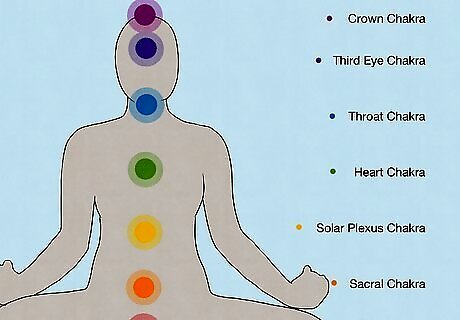
The 7 chakras are the body’s energy source. In Hinduism, chakras are the energetic powerhouse of the body. Translating to “wheels” in Sanskrit, chakras are the spiritual emblems or points of energy within you. Each energetic point governs different emotions and frequencies, which are said to influence your overall health and well-being. Many believe nourishing your chakras can help you feel balanced and in tune with your surroundings. The 7 chakras are as follows: The root chakra (Muladhara) is at the base of the spine and governs safety, security, and stability. When imbalanced, it can cause insecurity, doubt, and loneliness. The sacral chakra (Svadhisthana) is in the lower abdomen and is associated with sexuality and creativity. When blocked, it can cause envy, lust, and jealousy. The solar plexus chakra (Manipura) is between the navel and diaphragm and controls individuality. When blocked, you may feel depressed or fatigued. The heart chakra (Anahata) is in the middle of the chest and is associated with love, compassion, and friendship. When imbalanced, you might feel anxious or detached from yourself. The throat chakra (Vishuddah) is in the throat and governs communication and gratitude. When blocked, it can cause suppressed emotions and shyness. The third eye chakra (Ajna) is between the brows and is associated with intuition and clarity. When imbalanced, you may be irrational or angry. The crown chakra (Sahasrara) is at the top of the head and controls intelligence and spirituality. When blocked, it can cause arrogance.
How to Do Chakra Meditation
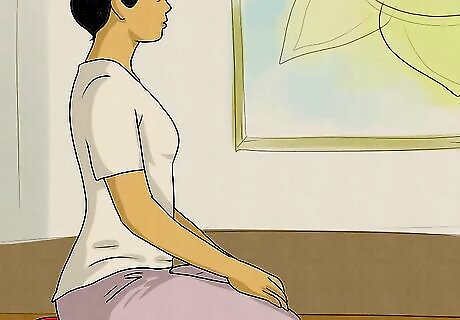
Sit in a comfortable position with your back straight. Settle down on the ground or on a chair in whatever position is most comfortable for you. Experts typically recommend sitting cross-legged with your shoulders back; however, you can also lie down with your legs and arms at your side.

Take a few deep breaths to calm your body. Before starting your meditation, it’s important to calm any built-up tension in the body. Breathe in and breathe out. Loosen the muscles in your face, relax your jaw, and place your hands wherever they’re most comfortable.
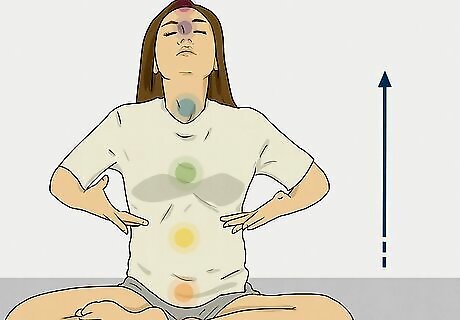
Close your eyes and visualize your 7 chakras. Once relaxed, close your eyes and think about the chakras running up and down the center of your body. Visualize where they rest and what they may look like. Are some glowing and vibrating? Are others stagnant and dull? Start at the base of your spine and move up to the crown of your head with the chakras in order, visualizing their energetic colors: Root chakra: Red Sacral chakra: Orange Solar plexus chakra: Yellow Heart chakra: Green Throat chakra: Blue Third eye chakra: Indigo Crown chakra: Violet or white
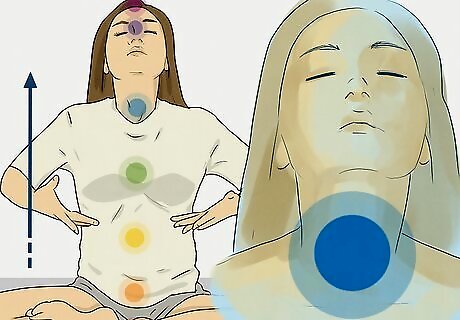
Breathe deeply and release tension from each chakra. Let go of all other thoughts and focus on your chakras. Start at the root chakra (the chakra on your tailbone) and visualize it pulsing with a bright light or energy. Then, imagine the light traveling up to the sacral chakra (the chakra in your lower abdomen). Continue this pattern until you reach the crown chakra (the chakra on the top of your head). Try imagining each chakra as a separate glowing orb, disc, or lotus flower—use whichever visual resonates most with you. Let your breath move the light and energy through your body like a wave, cleansing out all imperfections, imbalances, and negative energy. Stay on each chakra for as long as you’d like. The longer you visualize a chakra, the more energetic time it’ll have to heal.
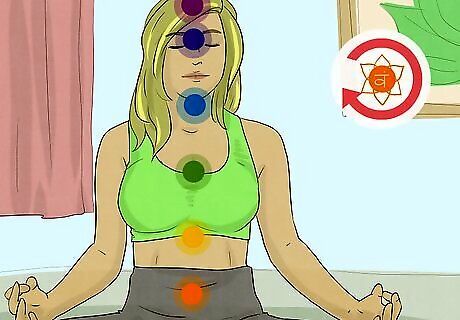
Visualize a wheel turning to align your chakras. If you reach a chakra that feels blocked or stagnant, focus on it for a few extra moments. Imagine the chakra as a wheel. Use your breath to turn the wheel clockwise. This can help correct the flow of energy in the body and within the blocked chakra, realigning your energetic power. Place your hand on the area of your body closest to the blocked chakra to help channel and focus your healing energy. For instance, if your sacral chakra is blocked, place a hand over your belly button.
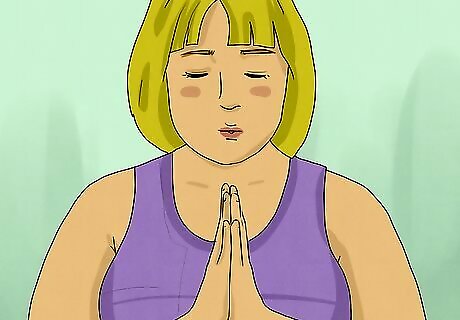
Open your eyes slowly to end your practice. Once you’ve visualized and breathed through each of your chakras, slowly open your eyes. Take a few deep breaths to center yourself with reality. Notice how you feel. If you feel energized, fantastic! If you still feel stuck, consider diving back into another round of meditation or jumping into a yoga flow. Your chakra meditation can be as long or short as you like. Remember, this meditation is to aid you and your needs, no one else’s.
What are the benefits of chakra meditation?
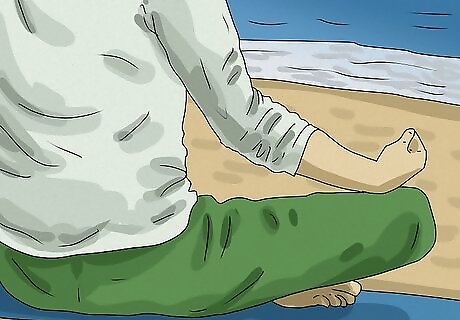
Meditation can help align and unblock your chakras. You'll feel like anything but yourself when a chakra is blocked or out of balance. Blocked chakras create an energy imbalance that can upset your mood or spiritual health. Many holistic healers believe that meditating can help balance your chakras and align your energy so you can be the best version of yourself. Not sure which chakra is blocked? Take our chakra test to find out which chakra you need to balance.
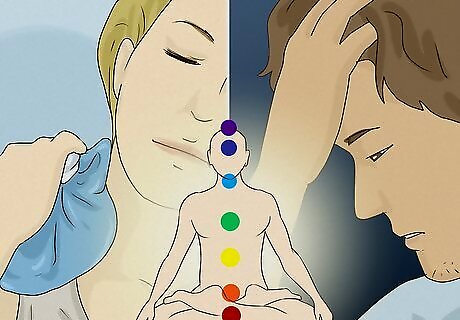
Chakra meditation may help alleviate physical and mental symptoms. Say you’re feeling unwell or a bit stuck lately. Some believe that meditating on a specific chakra (especially if it’s blocked) can help you feel like yourself again. Take a look at these physical and mental ailments and their associated chakras. Then, if you’re experiencing any of these symptoms, try meditating on the appropriate chakra to balance spiritual energy. Root chakra: Insecurity, anxiety, lack of purpose, constipation Sacral chakra: Jealousy, stiff lower back, lack of inspiration, irritability Solar plexus chakra: Muscle weakness, poor self-esteem, perfectionism, egotism Heart chakra: High blood pressure, poor emotional boundaries, self-sabotage, fear of rejection Throat chakra: Sore throat, stiff neck, hearing problems, lying, fear of speaking up Third eye chakra: Headaches, dizziness, manipulation, blurred vision Crown chakra: Frustration, apathy, depression, poor coordination
How to Get the Most Out of Your Meditation
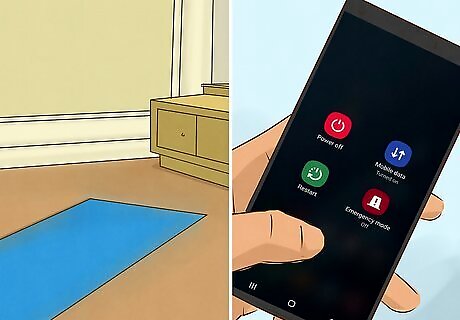
Choose a calm and relaxing environment to meditate in. While you can meditate anywhere, picking a space that’s comfortable for you is ideal. Opt for a dark, quiet room free from distractions. Turn off all electronics (TVs, radios, cell phones, etc.) and dim all the lights. Close the doors and windows to prevent any future distractions, and make sure there’s a cozy place for you to sit or lay (yoga mat, couch, bed, etc.). Light a candle or turn on some fairy lights to make the space extra cozy. Diffuse essential oils to help calm your energy and make the space more inviting. Ask your friends and/or family not to enter the space for a designated time. This way, you won’t have to worry about outward distractions.

Wear loose, comfortable clothing. Similarly to your environment, it doesn’t necessarily matter what you wear while meditating, but your attire could help you be more relaxed and in tune with your practice. Opt for soft clothing that doesn’t constrain you. For instance, swap your jeans for sweatpants or leggings and go for a baggy T-shirt over a formal top. At the end of the day, it doesn’t matter what you wear to meditate—wear whatever you’re most comfortable in.

Set a timer. Your meditation can be as long or short as you’d like. One of the many beauties of meditation is that you can adapt your practice to match your specific needs. If you only have 5 minutes to meditate before work, perfect! If you can try a lengthier 20-minute practice, that’s just as great! Set a timer on your watch or phone for your designated time. Then, try to meditate and focus on your breath and chakras until the timer goes off. A timer can also help your mind from wandering to thoughts of how much time is left in the practice. Simply keep breathing and focusing until the timer goes off. You know how much time you’ve allotted yourself, so there’s no worry if you’ve been meditating for too long.

















Comments
0 comment